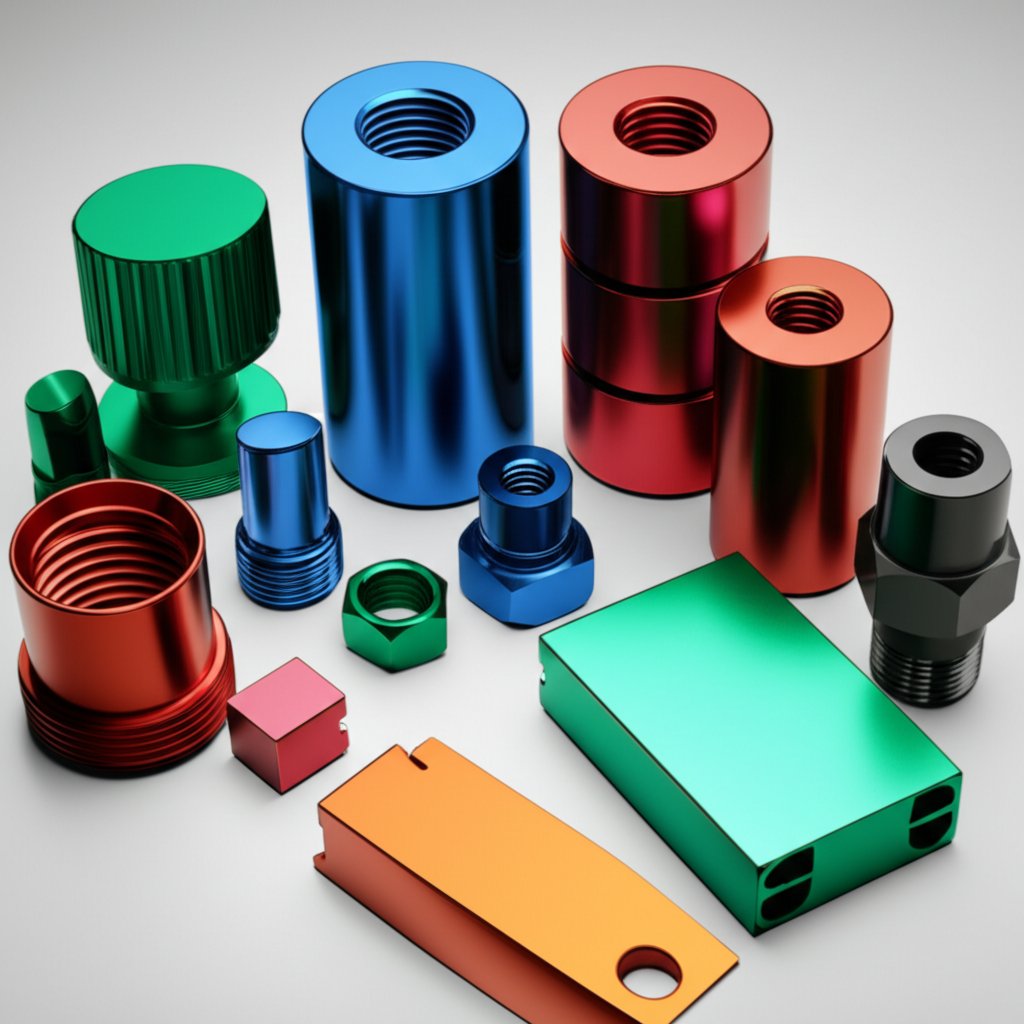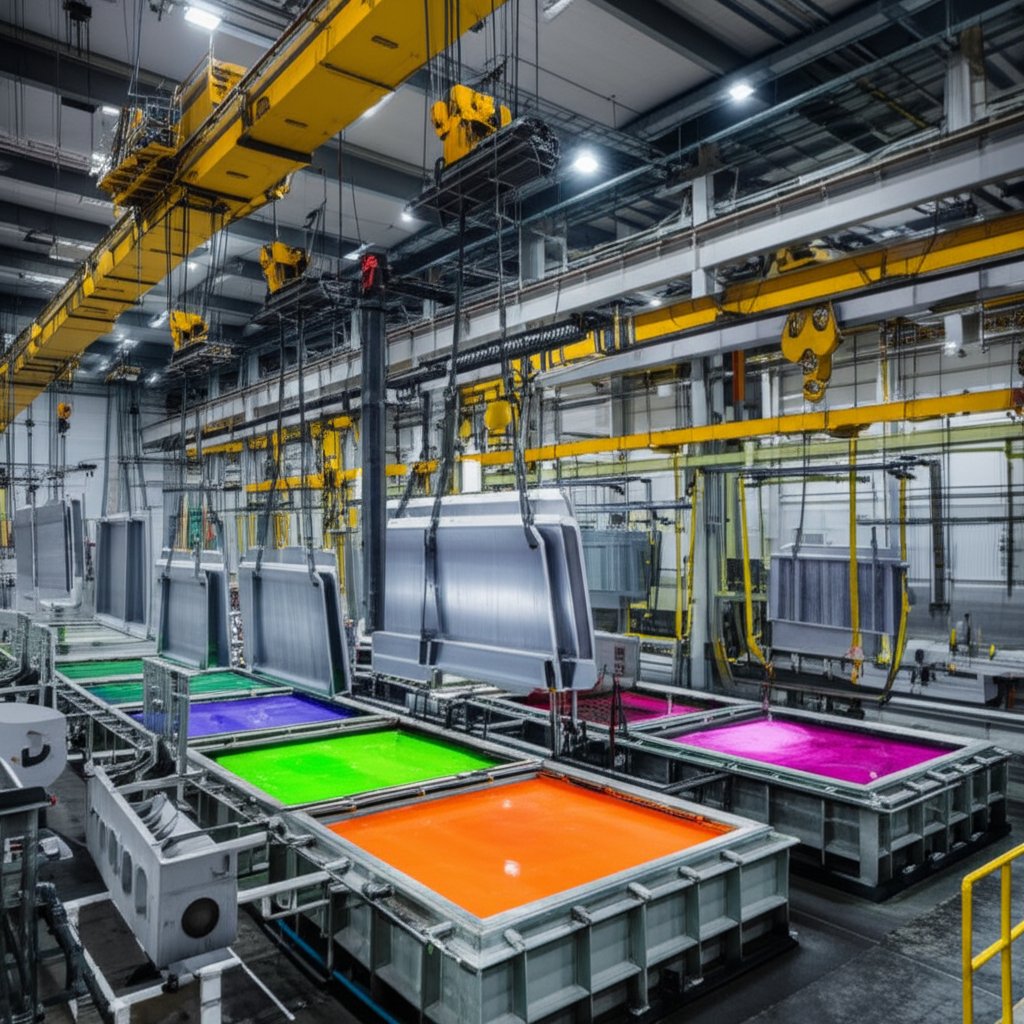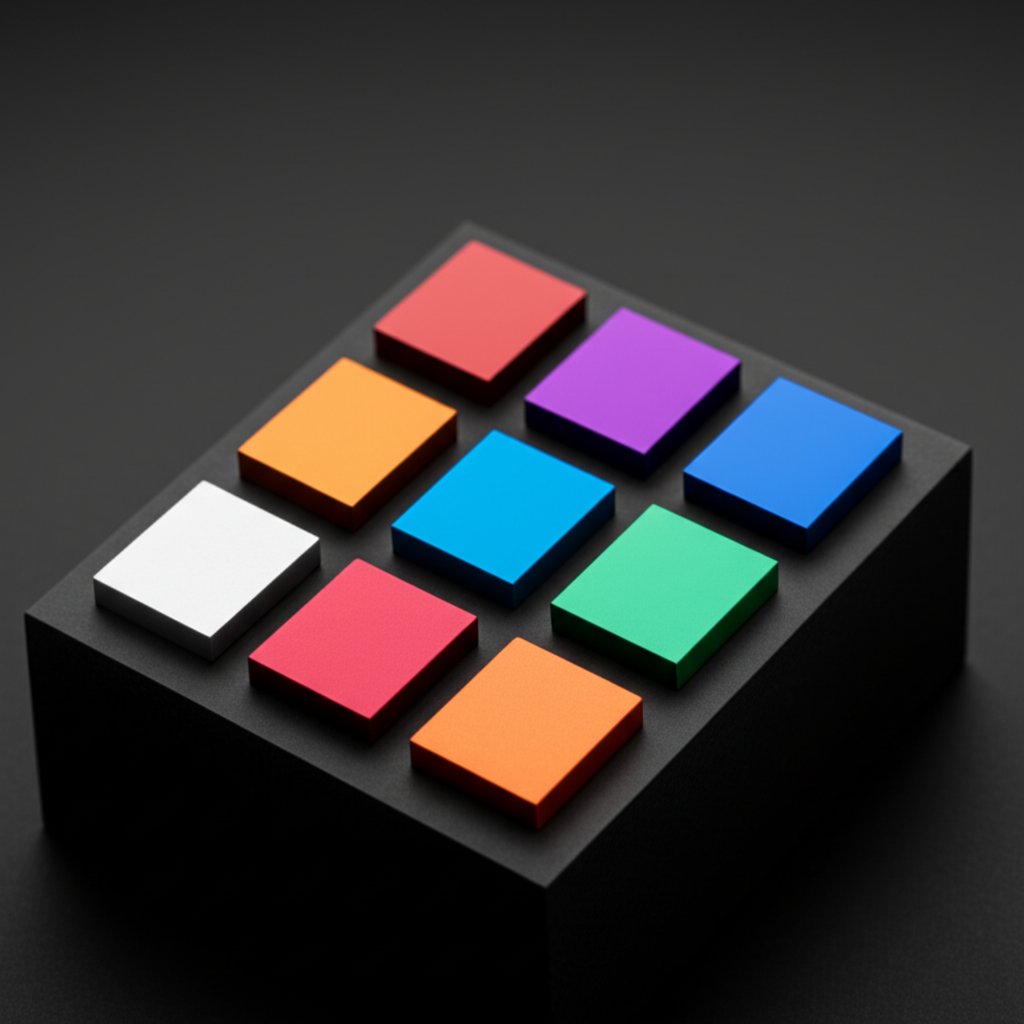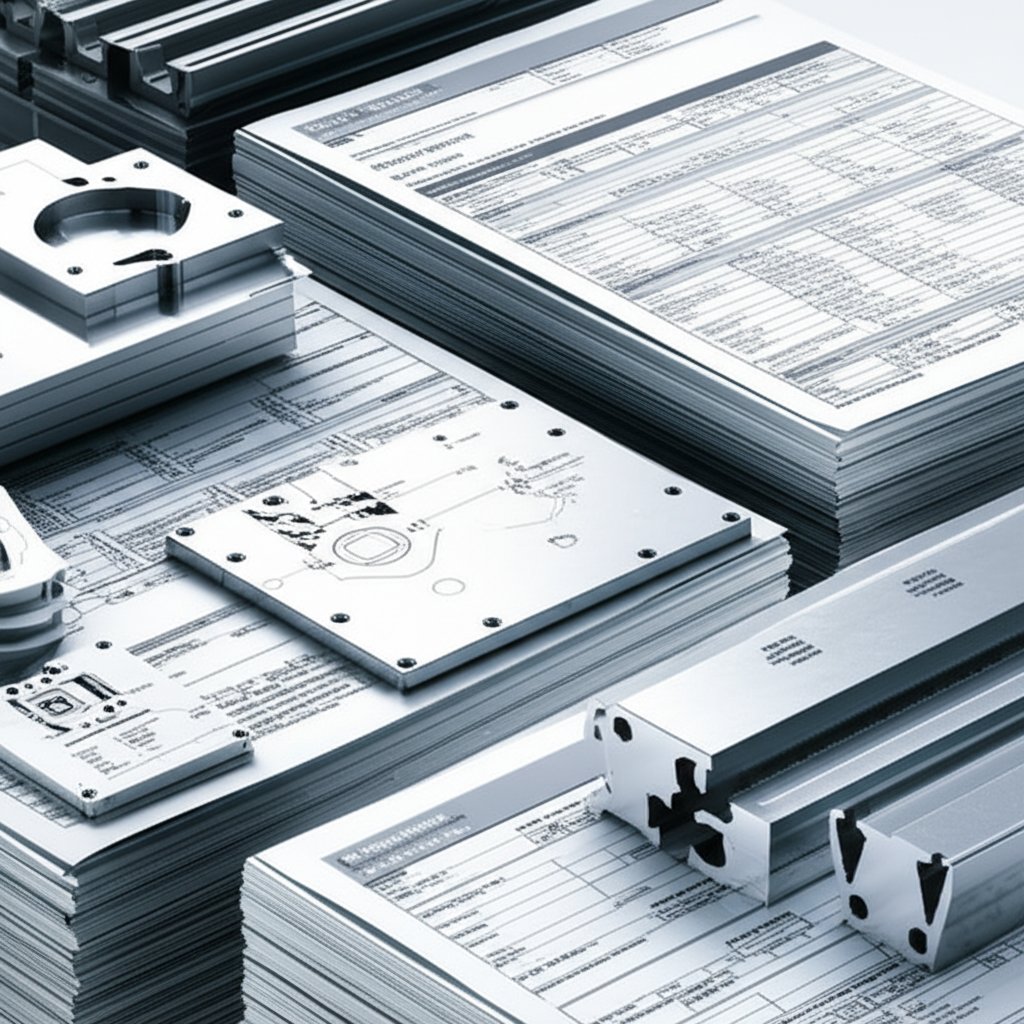
Ever wondered why some aluminum parts outlast others, keep their color, and resist scratches even in tough environments? The answer often lies in a single process: anodizing. So, what is anodized aluminum? Simply put, it’s aluminum that has been electrochemically transformed at the surface, creating a robust layer of aluminum oxide that’s integral to the metal itself—not just a coating or paint. This layer is much thicker and stronger than the thin oxide film that forms naturally on raw aluminum, dramatically improving durability and longevity.
Sounds complex? Imagine dipping a clean aluminum part into a special acid bath and running an electric current through it. The aluminum acts as the anode (hence ‘anodizing’), and oxygen from the electrolyte bonds with the surface, building up a controlled, uniform oxide layer. This process doesn’t add any foreign material—instead, it transforms the outermost layer of the aluminum itself. Afterward, the part is usually sealed to lock in color and keep out contaminants. The result: a finish that’s tough, stable, and visually customizable.
Here’s a key insight: The anodized layer is naturally porous after formation—this is what allows it to absorb dyes for color, but it also means sealing is essential to maximize corrosion resistance and lock in performance.
When comparing anodized aluminum vs aluminum in its raw state, the differences are striking. Raw aluminum is lightweight and naturally forms a thin oxide film, but this layer is fragile and easily damaged. Anodized aluminum, on the other hand, features a much thicker, engineered oxide layer that’s tightly bonded to the base metal. This makes it far more resistant to scratches, fading, and environmental wear. It’s also more visually versatile, offering a range of colors and finishes that raw aluminum simply can’t match.
These advantages make anodized aluminum material a top choice for demanding applications. You’ll find it in:
It’s important to note that anodized aluminum is not paint, powder coating, or plating. The finish is part of the metal itself, so it won’t chip, peel, or flake off under stress.
Understanding what is anodizing and why anodized aluminum is valued gives you a foundation for smarter buying and specifying. In the next sections, you’ll discover how industrial-scale anodizing is controlled, how to select the right finish for your needs, and what standards and procurement tools help ensure consistent results. Whether you’re an engineer, architect, or procurement specialist, you’ll find practical answers to choosing and sourcing the best anodized aluminum for your project.

Ever wondered how the flawless finish on architectural panels or aerospace parts is achieved? It’s not a DIY trick—it’s the result of a tightly controlled, industrial-scale anodizing aluminum process. Let’s break it down, step by step, so you know exactly what happens inside a professional anodising machine or anodizing line.
Each of these steps is monitored and adjusted based on alloy, part geometry, and end-use requirements. Skipping or mishandling any stage can lead to visible defects or compromised performance (AluConsult).
| Parameter | Typical Range/Target | Purpose |
|---|---|---|
| Sulfuric acid concentration | 15–20% by volume | Controls oxide growth rate and structure |
| Bath temperature |
18–22°C (64–72°F) for Type II –2 to 10°C (28–50°F) for hardcoat |
Lower temps = harder, denser coatings |
| Current density | 12–24 A/ft² (1.3–2.6 A/dm²) | Determines oxide thickness and uniformity |
| Voltage ramp profile | Gradual increase to 12–24 V | Prevents burning, ensures even growth |
| Time vs. thickness | 0.0002–0.001" (5–25 μm) in 20–60 min | Thicker for hardcoat, thinner for decorative |
Operators use precise controls—like agitation/air sparging for uniformity, filtration to remove contaminants, and strategic racking to ensure even current distribution. The choice of cathode material (often lead or stainless steel) and the quality of anodize solutions directly affect the outcome.
Even in the best-run plants, issues can arise. Here’s a troubleshooting guide for the most common challenges:
Remember, alloy choice and surface preparation are foundational—some alloys are more prone to smut, stains, or adhesion issues, so always share alloy and manufacturing history with your anodizer.
Sealing conditions—temperature, chemistry, and time—directly affect corrosion resistance and dye fastness. This step sets the stage for the next chapter, where you’ll learn how finish type, thickness, and sealing choices are matched to specific applications and performance standards.
When you’re specifying or buying anodized aluminum, one of the first questions you’ll face is: which types of anodize are right for your project? The answer depends on your needs for durability, aesthetics, and cost. Here’s a quick breakdown:
| Type | Main Electrolyte | Typical Thickness | Hardness | Color Options | Electrical Insulation | Cost Impact |
|---|---|---|---|---|---|---|
| Type I (Chromic) | Chromic Acid | 0.00002"–0.00007" | Good | Limited | High | $$$ |
| Type II (Sulfuric) | Sulfuric Acid | 0.0001"–0.0005" | Very Good | Wide (clear anodize, dyed) | High | $ |
| Type III (Hardcoat/Hard Anodize) | Sulfuric Acid (cold, high current) | 0.001"–0.002" (up to 0.006" possible) | Exceptional (65–70 Rc; harder than hard chrome) | Usually dark gray/black, can be dyed | Highest | $$ |
Type II is the workhorse for most architectural, consumer, and decorative applications—think laptop shells or window frames. Type III, also known as hard anodize or hard coat anodizing, is engineered for extreme wear and abrasion resistance, making it the go-to for aerospace, military, and heavy-duty industrial parts. Type I is less common but is still specified for certain aerospace and legacy parts where thin, highly conformal coatings are needed.
Imagine you’re choosing between a phone case and a hydraulic piston. The needs are very different—and so is the right anodizing type. Here’s how thickness and hardness stack up:
Hard-anodized aluminum is prized for its ability to withstand harsh environments and repeated use without losing performance. But keep in mind: thicker isn’t always better. Overly thick coatings can affect part tolerances, increase brittleness, and cause color variation, especially on complex shapes or different alloys.
After anodizing, the oxide layer is naturally porous—great for dyeing, but vulnerable to contamination and corrosion if left open. Sealing closes these pores and locks in color and performance. But which seal is best?
Choosing the right seal impacts corrosion resistance, dye fastness, and long-term appearance. For high-spec work, always specify the sealing method and test requirements.
Practical tips: Always state minimum and maximum thickness for wear faces, and specify masking for surfaces with tight tolerances to avoid unwanted oxide buildup. Remember, the right combination of types of anodize, thickness, and sealing is what delivers performance tailored to your application—not just a generic hard-anodized aluminum finish.
Up next: You’ll see how coloring technologies and alloy selection affect the final appearance, durability, and consistency of your anodized aluminum parts, so you can confidently specify finishes that look as good as they perform.

Here’s the secret behind vibrant anodized aluminum colors: the color lives inside the tiny pores of the oxide layer before sealing. The size and structure of these pores—plus how thoroughly they’re sealed—directly affect how rich the color appears and how long it resists fading.
When you picture black anodized aluminum on a bike part or the rich bronze of an architectural panel, you’re seeing the results of two main coloring methods: dye (adsorption) and electrolytic coloring. Each method offers unique benefits for different applications and color requirements.
| Coloring Method | Color Range (Gamut) | UV/Light Fastness | Cost | Batch Consistency | Typical Uses |
|---|---|---|---|---|---|
| Dye (Adsorption) | Wide (nearly all colors, including bright hues) | Variable (can fade outdoors, especially reds/blues) | Low | Good with controls | Consumer electronics, indoor decor |
| Electrolytic (Two-step) | Narrow (mainly bronze to black) | Excellent (very resistant to UV) | Moderate | Very high | Architectural, exterior, aerospace |
| Integral | Bronze to black (limited) | Excellent | High | High | Specialty, high-wear parts |
| Interference | Blue, green, pink/red, yellow | Excellent | High | High | Architectural, decorative |
With dye coloring, the freshly anodized part is immersed in an organic or inorganic dye bath. The open pores soak up the dye, and sealing locks the color in. This method is popular for clear anodized aluminum with subtle tints or for vivid custom shades. However, its UV resistance depends on the dye chemistry—making it better for indoor or low-sunlight applications (AluConsult).
Electrolytic coloring, often called the two-step process, uses metal salts (usually tin) and an electric current to deposit color in the pores. This method is prized for deep, stable bronze or black finishes—think dark bronze anodized window frames that withstand decades of sunlight. Integral coloring combines anodizing and coloring in one step for ultra-durable, abrasion-resistant finishes, but is less common due to cost. Interference coloring, a newer technique, modifies pore structure to produce unique, vibrant hues with outstanding lightfastness.
Did you know your choice of aluminum alloy can shift the final shade or gloss? Here’s how:
Even within a single alloy, minor differences in chemistry between lots can cause subtle color shifts. That’s why specifying "Anodize Quality" (AQ) aluminum and sourcing all visible parts from the same batch is essential for color matching—especially with clear anodized aluminum or large assemblies.
For large or critical projects, insist on color samples and batch testing to ensure all parts match your target from the anodizing colors chart. Even small changes in process or material can affect the final look, so close communication with your supplier is key.
Ready to specify the perfect finish? Next, you’ll learn how to test and verify quality—so your anodized aluminum colors not only look great but also perform as promised in the toughest real-world conditions.
When you’re specifying an anodized finish for critical projects, it’s easy to get lost in a sea of standards and acronyms. But don’t worry—most requirements boil down to a handful of globally recognized references. Here’s a practical comparison to help you match your needs to the right test or guideline:
| Requirement | Standard/Reference | What It Covers |
|---|---|---|
| Thickness & Type | MIL-PRF-8625 / mil std 8625 | Defines anodized coating types, classes, and minimum thickness for military and aerospace applications |
| Architectural Performance | AAMA 611 | Specifies performance for architectural aluminum finishes, including durability, color, and seal quality |
| General Anodic Coating | ASTM B580 | Guidance for anodic coatings on aluminum for general industrial use |
| Thickness Measurement |
ASTM B244 (eddy-current) ASTM B487 (coulometric) |
Methods for measuring anodized film thickness on finished parts |
| Seal Quality |
ASTM B136 (dye stain) ASTM B680 (weight loss) |
Tests for sealing integrity and resistance to dye/contaminant ingress |
| Corrosion Resistance | ASTM B117 | Salt spray (fog) test to evaluate corrosion resistance of aluminum coatings |
| Wear Resistance | ASTM D4060 (Taber) | Comparative wear testing for anodized coatings and other aluminum finishes |
For architectural or exterior work, AAMA 611 is your go-to, while mil std 8625 is the gold standard for aerospace and defense. Always cite the revision letter and specify both type (e.g., Type II or III) and class (thickness or intended use) in your documents (AAC).
How do you know your anodized aluminum finish meets spec? The answer lies in precise, reliable measurement. The most common method is the eddy-current technique (ASTM B244), using a portable gauge with either a built-in or separate probe. These instruments are quick, non-destructive, and suitable for both flat and curved parts, though probe calibration and geometry matter for accuracy.
For lab verification or cross-checking, coulometric dissolution (ASTM B487) provides a direct thickness readout by chemically stripping the oxide. This method is more precise but destructive—best for periodic checks or dispute resolution.
Sealing is what transforms a porous oxide into a robust, weather-resistant anodized coating. To verify quality, you’ll want to run one or more of these tests:
For high-wear or demanding environments, Taber abrasion testing (ASTM D4060) can help compare the durability of different aluminum finishes.
Imagine receiving a shipment of anodized aluminum parts: how do you confirm they meet your requirements? Here’s a practical checklist for incoming inspection:
For authoritative sourcing and deeper technical guidance, link directly to documents from ASM International, The Aluminum Association, or ISO catalogs. This ensures your team and suppliers are always working from the same page.
"A robust quality assurance plan—anchored to recognized standards and real-world tests—is the single best way to ensure your anodized aluminum finish delivers on both performance and appearance."
Next, you’ll discover how to turn these requirements into clear procurement specs and RFQ tools, making it easy to communicate expectations and avoid costly rework or disputes.

When you’re ready to source anodized aluminum parts, clear and complete specifications are your best defense against costly mistakes. Imagine sending out an RFQ only to get back a dozen different interpretations—frustrating, right? To avoid this, use a standardized specification block that covers all the critical details. Here’s a copy-ready example you can adapt to your own needs:
Sample Anodized Aluminum Specification:
Material: [Alloy & Temper, e.g., 6063-T5]
Surface Prep: [e.g., Satin etch, bright dip]
Anodize Type/Thickness: [Type II, 0.4 mil min. on all exposed faces]
Sealing: [Nickel acetate, hot water, or as required]
Color: [Specify color, e.g., clear, black, bronze; include delta-E tolerance if needed]
Masking: [Detail areas to be masked or left uncoated]
Test Methods: [ASTM B244 for thickness, ASTM B136 for seal, ASTM B117 for corrosion, etc.]
Acceptance Criteria: [Minimum/maximum thickness, color match, surface finish, etc.]
Reference Standards: [e.g., MIL-PRF-8625, AAMA 611, ASTM B580]
Want to cut RFQ cycles and reduce risk? Make sure your drawings and requests for quote include every detail suppliers need to deliver a compliant product. Here’s a practical checklist for anodized aluminum sheet, anodized aluminum sheet metal, or anodized aluminum plate orders:
Ever wondered why the cost to anodize aluminum can vary so much? It’s not just about the size of your order. Multiple factors impact the final price and turnaround:
| Cost Driver | Impact | Strategy |
|---|---|---|
| Alloy family & surface prep | Some alloys require more cleaning or etching; complex preps add labor | Choose standard alloys and finishes where possible |
| Thickness & color method | Hardcoat (Type III) and custom colors cost more due to longer process and special dyes | Use Type II or standard colors unless extra durability is needed |
| Masking complexity | More masking = higher labor cost and risk of defects | Limit masking to only critical areas |
| Lot size & racking density | Larger lots and efficient racking lower per-part cost; small runs are pricier | Consolidate orders and discuss racking with your supplier |
| Geometry & rework risk | Intricate shapes or thin sections increase process time and risk of rejects | Simplify part design if possible |
Pro tip: Use an anodizing cost calculator to estimate pricing for your specific scenario. Many suppliers provide these tools online, helping you balance anodizing cost and performance requirements.
Protecting your finished parts from scratches, contamination, or corrosion during shipping is just as important as the anodizing itself. Here are best practices for packaging anodized aluminum sheet metal or plate:
For long extrusions or oversized parts, always confirm that your supplier’s rectifier capacity and tank dimensions can handle the full length and width of your order. This simple step can prevent last-minute surprises and ensure your anodized aluminum parts arrive in perfect condition.
With these procurement tools and checklists, you’ll spend less time clarifying specs and more time getting reliable, high-quality anodized aluminum. Up next, we’ll cover maintenance, repair, and DIY safety—so you can keep your finishes looking and performing their best for years to come.
Ever noticed your aluminum window frames or bike parts losing their luster? Routine care is the secret to keeping anodized aluminum looking sharp. The good news: maintenance is straightforward. Use only pH-neutral cleaners and a soft cloth or sponge—think mild soap, not harsh chemicals. Avoid strong acids, alkalis, or abrasive pads that can damage the finish. If you’re tackling stubborn dirt or stains, start with water and gentle scrubbing; for heavier buildup, a mild detergent is safe. Always rinse thoroughly and dry with a soft, lint-free cloth to prevent water spots.
What if you discover a scratch or scuff—can you fix it yourself? Minor blemishes on anodized aluminum can often be blended with non-wax polishes or specialized color blending pens. For clear finishes, a gentle abrasive pad may help, but sanding is not recommended, as the anodic layer is harder than most sandpaper and you risk uneven results. For dyed finishes, selective re-dyeing is possible but matching the exact color can be tricky.
Wondering how to tell if aluminum is anodized? Look for a matte, less reflective surface that resists dye removal and scratches. If the damage extends into the base metal or if you’re dealing with a hardcoat (Type III) finish, full strip and re-anodizing is needed—a process best left to professionals due to the chemicals and precision required (Sciencing).
Thinking about home anodizing aluminum or repairing a small part in your garage? While diy anodize is possible for hobbyists, there are strict boundaries for safety and quality. Only attempt DIY anodizing or touch-up on small, non-critical parts where color and thickness variations are acceptable. Here’s a practical checklist to stay safe:
When learning how to anodize aluminum at home, remember that the process involves strong acids and requires careful handling. DIY setups can yield vibrant results and let you experiment with how to color aluminum, but they rarely match the consistency or durability of professional finishes. For tasks like how to black anodize aluminum, specialized dyes and precise control are needed to avoid uneven color.
Environmental, Health, and Safety (EHS) practices are critical, even for small DIY jobs. Always capture and neutralize acidic or alkaline waste before disposal. Segregate any residues containing heavy metals (from sealants or dyes) and follow local regulations—consult EPA or REACH guidelines as needed. Never pour chemicals down the drain or into the environment.
For more complex repairs, or if you need to restore performance on architectural or high-value parts, commercial anodizing shops offer significant advantages: precise racking for even coverage, industrial rectifier control for consistent oxide growth, and professional sealing for maximum corrosion and color stability. Their quality control far surpasses what’s possible with home anodizing aluminum or DIY kits.
“DIY anodizing can be fun and rewarding for makers, but for critical repairs or uniform color and durability, trust a professional shop. Their process control and safety standards protect both your project and the environment.”
Ready to see how real-world projects put these lessons into practice? Next, we’ll dive into case studies and performance data, giving you measurable results to back your anodized aluminum decisions.
Imagine specifying an aluminum curtain wall for a high-rise that must retain its color for decades under intense sunlight. The project called for a consistent aluminum dark bronze finish across hundreds of anodized extruded aluminum profiles. The specifier chose 6063-T5 alloy, Type II anodize at 20 microns, electrolytic bronze coloring, and nickel acetate sealing. Accelerated UV and salt-spray tests (ASTM B117) were run. After 3,000 hours of UV exposure, the delta-E color drift was less than 2.0—well within architectural standards. Salt-spray testing showed no pitting or staining at 1,000 hours, confirming the finish’s long-term stability. The lesson? Pairing a robust alloy with electrolytic coloring and proper sealing yields enduring, uniform dark bronze anodized aluminum facades that stand up to real-world weathering.
For a landing gear component exposed to abrasion and hydraulic fluids, engineers specified 6061-T6 alloy, Type III hard anodization of aluminum (hardcoat), 50 microns thick, left unsealed for maximum wear resistance. Taber abrasion testing (ASTM D4060) yielded a wear index of 8.4 mg/10,000 cycles—easily passing MIL-PRF-8625 requirements. However, salt-spray corrosion resistance was limited (failure at 43 hours), highlighting the classic trade-off: unsealed hardcoat maximizes wear resistance but is best used where corrosion is controlled by design or additional protection (METALAST International Study).
Boat hardware, constantly exposed to saltwater, demands a finish that can resist corrosion and retain appearance. Here, 6061-T6 alloy parts were treated with Type II anodize at 25 microns, dyed black, and sealed in nickel acetate. Salt-spray testing showed failure at 495 hours, while sodium dichromate-sealed parts exceeded 1,500 hours before pitting appeared. The takeaway: for marine use, select sealing chemistry carefully—dichromate or silicate seals can greatly extend the service life of both clear and colored finishes, while dyeing alone may reduce wear resistance.
For a premium audio device, the goal was a flawless clear anodized aluminum finish that resists fingerprints and daily handling. 6063 alloy, Type II clear anodize at 10 microns, hot water sealed, was used. After 1,000 hours of simulated handling and UV exposure, the finish retained its gloss and transparency, with no visible yellowing or haze. This underscores why clear anodize remains the go-to for high-touch, visually demanding products.
| Application | Alloy/Type | Thickness (μm) | Seal | Salt-Spray Hours* | Taber Wear Index (mg/10k) | Color Drift (ΔE) |
|---|---|---|---|---|---|---|
| Facade (dark bronze) | 6063-T5/Type II | 20 | Nickel acetate | 1,000+ | 13.9 | <2.0 |
| Aerospace (hardcoat) | 6061-T6/Type III | 50 | Unsealed | 43 | 8.4 | n/a |
| Marine hardware | 6061-T6/Type II | 25 | Nickel acetate | 495 | 15.0 | n/a |
| Marine hardware (enhanced) | 6061-T6/Type II | 25 | Sodium dichromate | 1,578 | 9.8 | n/a |
| Consumer electronics | 6063/Type II | 10 | Hot water | n/a | 13.9 | <1.0 |
*Hours to failure in ASTM B117 salt spray test (failure = 5 pits in 387 cm2)
Key takeaways:
- Small changes—like switching from nickel acetate to dichromate seal—can double or triple corrosion resistance.
- Unsealed hard anodized finishes deliver top wear resistance but less corrosion protection.
- Electrolytic coloring and robust sealing are essential for color stability in architectural and dark anodized aluminum applications.
Whether you need gold anodized trim for a decorative accent, or a rugged finish for dark bronze anodized aluminum exterior panels, these data-driven scenarios show how thoughtful choices in alloy, thickness, coloring, and sealing directly affect real-world performance. Up next, you’ll learn how to evaluate and source suppliers who can deliver these results, so your anodized aluminum projects succeed from start to finish.

When you’re ready to source anodized products for your next project, asking the right questions up front is essential—especially if you’re searching for “anodized aluminum near me” or considering international partners. Start with these:
Choosing a supplier who offers both extrusion and anodizing in-house can streamline your supply chain and reduce risk. Imagine the difference: instead of coordinating between multiple vendors, you get consistent quality, color matching, and faster turnaround—all from a single source. This is especially important for large architectural projects or when you need long, complex profiles with a uniform aluminium anodized finish.
| Supplier Capability | What to Look For | Why It Matters |
|---|---|---|
| Alloys & Extrusion Sizes | Full range (e.g., 6000, 7000 series; small trims to large beams) | Ensures fit for your application, from anodized aluminum trim to structural members |
| Anodize Types & Max Lengths | Type II, Type III (hardcoat); ability to handle long extrusions/sheets | Guarantees both decorative and industrial performance in one place |
| QA Instrumentation | Eddy-current, coulometric, colorimetry, gloss meters | Delivers measurable, repeatable quality |
| Certifications | ISO 9001, ISO 14001, AAMA 611, etc. | Signals commitment to quality and compliance |
| Lead Time & Logistics | Clear timelines, export packing, and shipping support | Reduces delays and protects finish integrity in transit |
For projects demanding both extrusion and anodizing, consider manufacturers like Aluminum Profile from Shengxin. Their integrated approach helps ensure a consistent finish on long extrusions and tight QA for architectural and industrial runs. Always request sample panels and full test reports before issuing a purchase order, regardless of supplier location.
Wondering if you should source from a local aluminium anodizing plant or look overseas? Here’s a quick comparison:
| ✔ | Confirm rack design is suitable for your part geometry |
| ✔ | Request thickness uniformity data across sample panels |
| ✔ | Ask for sealed color chips or anodized aluminum trim samples |
| ✔ | State masking needs and verify masking process plans |
| ✔ | Review process control charts and QA records |
| ✔ | Check for up-to-date ISO or industry certifications |
| ✔ | Evaluate packing and logistics support for your region |
Whether you’re working with established aluminium anodisers or exploring new suppliers, this checklist helps you avoid common pitfalls and ensures your supplier can deliver the right aluminium anodized finish for your project.
Action Plan:With these steps, you’ll source anodized aluminum with confidence, whether locally or globally.
- Define your alloy, finish, and performance specs in writing.
- Vet suppliers using the checklist—ask for samples and QA data every time.
- Align on packaging, lead times, and export documentation before placing your order.
- Keep communication open—request updates and clarify expectations at each stage.
Anodized aluminum is aluminum that has undergone an electrochemical process to form a thick, durable oxide layer, making it much more resistant to corrosion and wear than untreated, raw aluminum. Unlike paint or plating, the anodized layer is part of the metal itself, providing enhanced longevity and a variety of color options.
Anodized aluminum does not rust like iron or steel, thanks to its protective oxide layer. This finish offers superior corrosion resistance, making it ideal for outdoor, marine, and high-traffic applications where durability is essential.
Key benefits include excellent corrosion and wear resistance, customizable colors and finishes, UV and thermal stability, low maintenance, and sustainability. These attributes make anodized aluminum a top choice for electronics, architecture, transportation, and more.
To achieve consistent results, specify alloy and finish details clearly, request color samples, and require suppliers to follow recognized standards like MIL-PRF-8625 or AAMA 611. Integrated suppliers, such as Shengxin Aluminum, offer extrusion and anodizing under one roof for better quality control.
Small cosmetic repairs and simple anodizing can be done at home on non-critical parts, but safety is crucial. Always use proper PPE, ensure good ventilation, and handle chemicals responsibly. For structural parts or professional results, commercial anodizing shops are recommended.
 Onlineservice
Onlineservice 0086 136 3563 2360
0086 136 3563 2360 sales@sxalu.com
sales@sxalu.com +86 136 3563 2360
+86 136 3563 2360